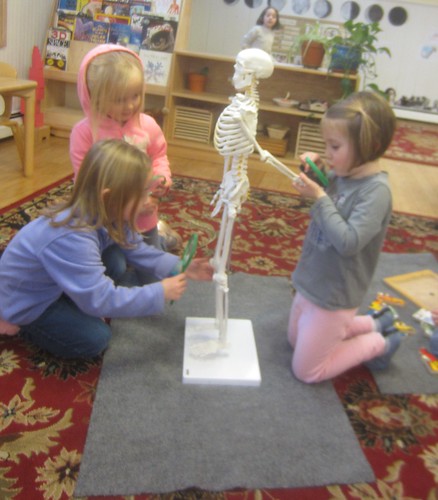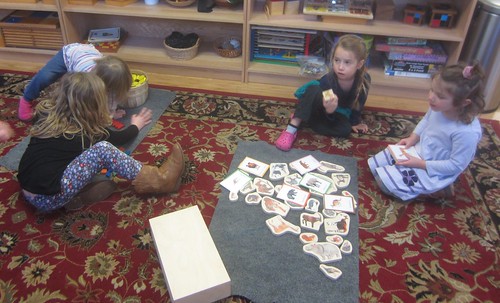The children have been using their imaginations to invent and play games with each other. Despite being mid January, the trucks and bikes have remained active. There have been games of chase and capture, games with instructions and rules to determine who will be the next to go, shoveling scoops of snow, sled rides, and truck driving. We were so excited for the big snowfall which turned the world into a snow covered wonderland. Some carrots from the fridge made great snowman noses, eyes, and ears.
Monday students used marbles to make their artwork by plonking them in jars of paint, then rolling them around on their papers to make colorful line designs and patterns.
The solar system was introduced, specifically the 8 (+dwarf Pluto = 9) planets. We will do a planet a week, working our way from the planets closest to the sun to the planet furthest away. We learned that all the planets in our solar system orbit our star, the sun, and that most of the planets have at least one moon that orbits that planet. This week we were introduced to the planet Mercury. We learned that it moves very quickly around the sun, but rotates very, very, very slowly, so one day to night period lasts 59 days. We learned that there is no atmosphere on Mercury, so asteroids strike the planet, leaving huge craters, just like the moon, but unlike Earth whose atmosphere burns most of them up before they can hit the surface. We also learned that daytime on Mercury is super hot, upwards of 400 degrees, but night is super cold, down to negative 280 degrees.
Susan shared the Greek Myth about the gods Gaea (Earth), Uranus, Saturn, Jupiter, Mercury, Venus, Mars, and Neptune. She told how Saturn, a son of Gaea and Uranus, would eat his children, so when Jupiter was born, his mother hid in a cave with him, and when he grew up he overthrew his father. Jupiter had several children, including Mercury. Mercury was very clever and quick. One day he tricked his brother, Apollo, by tying branches to the feet of 50 cows and walking them away backwards to it looked like they had been eaten by a giant monster. When Apollo deduced what had happened, Mercury gave him a lire that he had made, the first musical instrument. Because of his speed and cleverness, Mercury became the messenger of the gods.
The children made models of the planet mercury by tracing a template and cutting out a circle, then plopping a mixture of toilet paper, grated soap, water, glue, and black paint on it. They used marbles to create craters in the surface, then set them to dry. Each week we will make a new planet, which we will save to display for our last day art show.
The children made their Mercury mixture and a large batch of clean mud by grating bars of ivory soap, then combining it with torn pieces of toilet paper and water, then mushing and smooshing it up into a fun, soft, moldable mixture. They were all very careful while grating to keep their fingers safe. It was great fun to play with when all mixed together!
The health Center was once again very busy. There were plenty of doctors and nurses caring for the few patients who stopped in for exams. Tammy made some silhouettes of animals so the children could compare their height with a jack rabbit, a penguin, and a coyote.
Rachel returned to finish up the plant pressing with those who missed it last week, and to cover them all with contact paper to preserve them. Next week the children will share their collected plants with the group.
During sign language with Rose, after making all the signs for Rose that we have learned, she taught us some winter signs. We reviewed winter and learned snow pants (make the snow for snow by wiggling fingers coming down, then pants, which looks like pulling up pants), hat (patting your year)h, jacket, mittens, gloves, boots, and scarf. These will be quite handy when getting ready to go outside!
We continue to read and discuss making mistakes, taking on challenges, and being brave. We read Jabari Jumps about a boy who decides to jump from the diving board for the first time after completing swim lessons and passing the swim test. He is quite nervous, but with some gentle support and strategies from his dad, he takes some breaths, tells himself that he is ready, climbs up, and jumps off, being brave despite his nervousness with this scary new endeavor. We also read the true story of Emmanuel Ofosu Yeboah who was born with only one leg. He hopped to school, hopped to collect water, learned to play soccer and ride a bike, and travelled far away to a city where he worked to support his family at 13 years old. We tried hopping around on one leg and found it to be quite challenging. It is a truly inspiring story of perseverance, hard work, and determination.
We introduced yoga and had fun moving our bodies into different poses, including downward dog, swan, mountain, tree, cobra, and child’s pose. Every student then rested on their backs and a flat stone was placed on each belly. They moved the stone up and down while breathing deeply in to raise their bellies, then out to lower it down.
We celebrated a fourth birthday with tasty cupcakes. The birthday boy shared that he was born in the winter and he is four years old. He smiled his way through the seasons as he orbited the candle sun then we all sang Happy Birthday before enjoying tasty cupcakes together. Happy Birthday birthday boy!
During music we continued imitating rhythms, but with the purpose of communicating. Susan explained to us how satellites in space send messages back to earth through radio waves. She tapped out short rhythm patterns on a drum from across the classroom, and students took turns trying to tap them back. It was quite challenging to hear and repeat the rhythms!
For Friday science we explored the sense of touch. We watched some short videos about how the skin works and what your sense of touch is. We then got down to experimenting! We touched a variety of items and categorized them by texture (rough and smooth) and hardness (hard and soft).


























































































